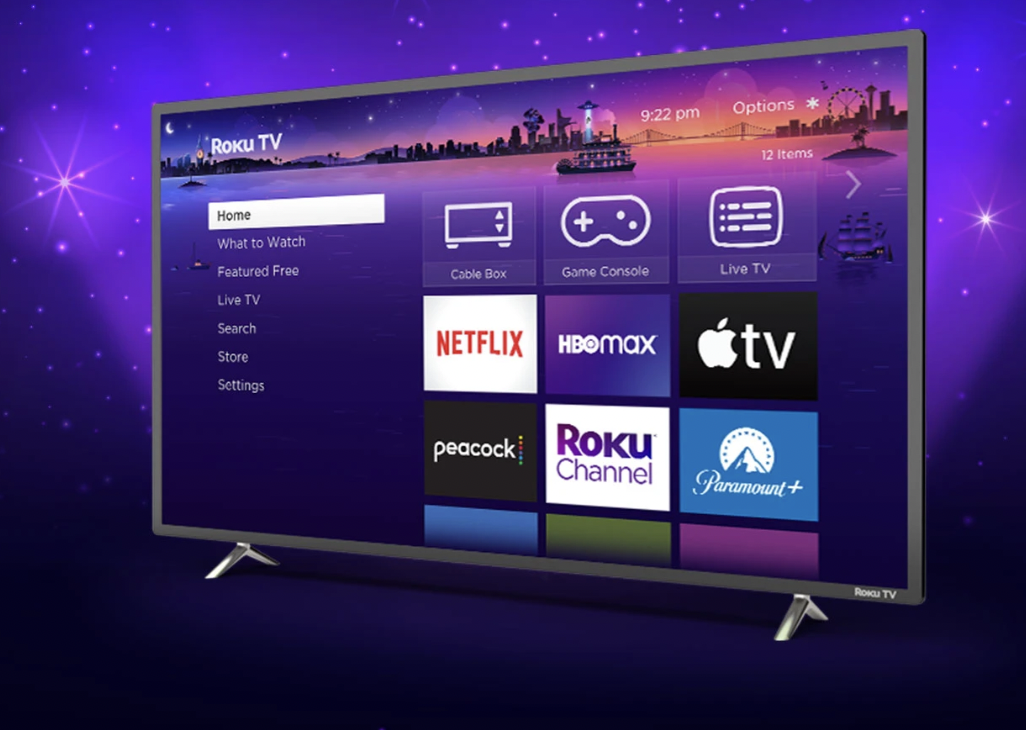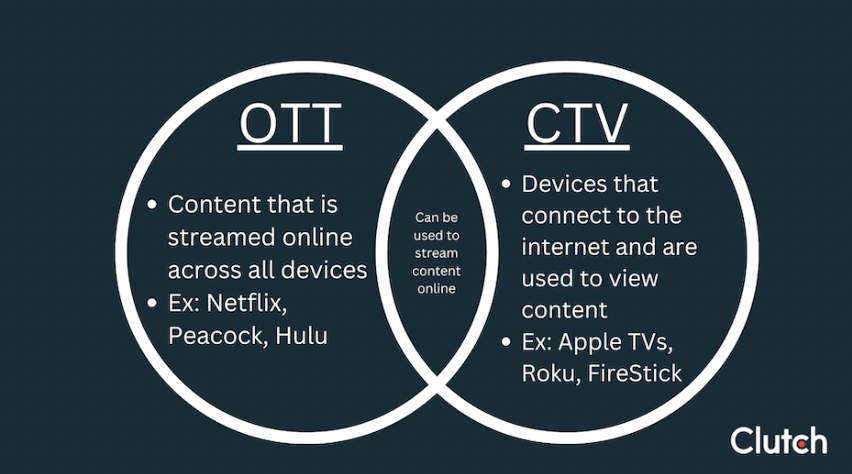![How to Create a Digital Marketing Budget [With Template]](https://img.shgstatic.com/clutch-static-prod/image/resize/715x400/s3fs-public/article/cbefcf801b6c486982d781482f9a654f.png)
![How to Create a Digital Marketing Budget [With Template]](https://img.shgstatic.com/clutch-static-prod/image/resize/715x400/s3fs-public/article/cbefcf801b6c486982d781482f9a654f.png)
Updated December 16, 2025
As technology is constantly evolving and changing, so should your business’ approach to tech-based advertising. One area ripe for marketing investment is connected TV (CTV) advertising.
In digital marketing, innovation should be a key part of your organizational strategy.
With the steady increase in popularity of streaming services over the past decade and the trend of “cord-cutters” abandoning traditional TV, leveraging CTV devices as a part of your digital advertising strategy can invigorate your marketing efforts.
Looking for a Digital Marketing agency?
Compare our list of top Digital Marketing companies near you
The data shows that smart businesses are building CTV campaigns. A 2022 Smart Insights survey found that 65% of marketing technology leaders are exploring or piloting technology to support CTV advertising.
CTV’s reliance on an Internet connection can allow you and your team to target audiences more effectively than you can via other video advertising channels. As other digital marketing channels become increasingly saturated, CTV ad campaigns can serve as a blue ocean in your advertising strategy.
This article will define and explain connected TV and connected TV advertising while reviewing the advantages of the advertising method and best practices for those exploring CTV advertising further.
Table of Contents
Capitalize on this trend quickly. Connect with the best CTV advertising agencies on Clutch.
Before diving into the depths of connected TV advertising practices and principles, we should first outline CTV.
A connected TV is a device that connects to or is embedded in a TV that uses an Internet connection to play video streaming content.

Source: Roku
At present, several connected TV platforms are available to consumers. These include, but are not limited to, the following:
Given that streaming services are a relatively new entrant to the media marketplace, you may assume that CTV needs time to mature before it becomes a viable marketing channel for your company. Consumer data suggests otherwise, though.
A 2022 survey from the Leichtman Research Group found that 87% of US TV households own a connected TV. This figure represents an almost 50% increase from a decade ago. Additionally, 46% of viewers in these households report using their connected devices daily.
Connected TV devices don’t necessarily have to be used to stream video only, so some of this connected TV use may be attributable to broadcast or cable TV. However, streaming use has also seen a rise in popularity in the recent past.
In fact, Nielsen reported that in July 2022, for the first time, streaming viewership eclipsed all other forms of TV viewership in the US with a 34.8% usage share.
Connected TVs are growing in popularity with consumers, so businesses and marketers should familiarize themselves with their nuances to keep their digital marketing strategy relevant.
As with any other new, tech-driven arena, the world of connected TV has several industry-specific terms that can be difficult for the uninitiated to differentiate.
One of these terms is “smart TV,” which refers to an Internet-enabled TV set that allows users to stream video content without using any auxiliary devices.
You may recognize some of the CTV devices listed above, such as Roku or Fire TV, as smart TV brands. Yet, not all connected TVs are smart TVs. A streaming stick or video game console that allows streaming would also qualify as a connected TV platform.
Another CTV-related term to understand is over-the-top programming.
OTT refers to a content provider that delivers streaming and on-demand video content through a separate physical device via the Internet.

Streaming services such as Netflix and Hulu are great examples of OTT programming providers. These services provide OTT content through apps loaded onto other Internet-enabled devices.
Connected TVs can play OTT programming. They are not the only types of devices that can do so, though. Mobile devices such as smartphones and tablets can also be used to stream OTT content.
Now that we’ve reviewed connected TV as a concept, we can begin discussing connected TV advertising.
CTV advertising is exactly what it sounds like: video ads played over connected TV devices.
These ads represent a growing segment in the world of multimedia marketing. According to a Statista survey taken at the end of 2021, 78% of US-based marketers intended to increase their CTV ad spend in 2022.
One aspect of CTV advertising that may be confusing for those first learning about it is that some OTT streaming services, such as HBO Max are ad-free.
In theory, this setup limits the effectiveness of your CTV campaigns by constraining the potential advertising channels. However, research from eMarketer suggests that by 2025, viewers of ad-supported streaming services will outnumber those of ad-free streaming services.
With a growing interest in streaming services and ad-supported streaming services, opportunities abound in the world of CTV advertising.
When you think of video advertising, the first thoughts that come to mind are probably thoughts of linear TV advertising. Linear TV refers to the traditional television setup where viewers watch programs on specific channels according to their broadcast schedule.
Linear TV ads have an iconic place in American media culture. In fact, 43% of those who took part in an August 2021 survey said they watched the Super Bowl for the commercials alone.
CTV ads, though, offer some distinct advantages over linear TV ads such as the following:
Read on for a more in-depth look at each advantage.
CTV has an audience base that is growing in both size and exclusivity.
We’ve already discussed the increased popularity of streaming services over the past decade. However, people choosing to stream over maintaining a cable subscription has made the CTV marketplace harder to reach via other channels.
The Pew Research Center found that in 2021, 44% of US adults don’t receive TV service to their homes via satellite or cable.
This figure represents an increase of 20% from 2015. Of this 44%, 61% had a cable or satellite subscription at some point in the past.
Based on this data, cord-cutters are a growing demographic that inherently can no longer be reached via traditional TV advertising.
It can be presumed that these viewers are now using streaming services, so CTV advertising represents an opportunity to re-reach them.
In addition to a greater reach, the connected TV platform can allow you and your team to display ads with enhanced viewer targeting.
Connected TV advertising allows for many targeting options, including the following:
As you can see, CTV advertising allows for user attributes collected via the Internet to be leveraged for targeting purposes in many manners. This versatility allows CTV campaigns to be fine-tuned based on your business needs and ideal buyer personas.
Regardless of the industry in which your company operates, there’s no doubt that your bottom line is among your chief concerns. Any opportunities to secure cost savings should be welcomed.
Working CTV advertising into your marketing plan is a great way to reduce your marketing budget while seeing enhanced returns.
According to Analytics Partners’ ROI Genome reports, CTV advertising has a 30% better return on investment than other advertising channels, including linear TV. Despite this, they’ve found that CTV ad spend is typically only 7% of a firm’s total ad spend.
This is markedly less than spent on linear TV and several other channels’ ads.
The cost-effectiveness of CTV advertising makes sense when you consider the other advantages we’ve detailed.
CTV ads provide a direct avenue to the elusive streaming service subscriber and cord-cutter markets. Furthermore, they can be tailored and targeted to specific market segments more easily than other channels’ ads.
With these advantages in tow, CTV advertisements can do more for marketers than other ads while costing less.
Learn more about how much advertising costs in Clutch's 'Advertising Agency Pricing Guide.'
After understanding connected TV advertising and the advantages it provides over linear TV advertising and campaigns run on other marketing channels, you’re probably considering how you can work CTV campaigns into your overall marketing plan.
To help you start on your CTV advertising journey, here are 3 best practices to keep in mind:
Keep reading to learn more about integrating these practices into your CTV advertising model.
Earlier in the article, we discussed the differences between connected TV and over-the-top programming. Comprehending these differences is key to understanding how CTV advertising fits into OTT advertising and driving a better CTV advertising strategy overall.
There are three types of CTV ads:
Moreover, as mentioned earlier, the streaming platforms that play CTV video content fall under the OTT umbrella and can also be played on smartphones, tablets, and other smart devices.
You and your team should consider these attributes when creating your CTV campaigns.
For instance, if you want to build a versatile CTV campaign that can be easily run concurrently on other OTT marketing channels, in-stream video ads would be your best choice.
On the other hand, an interactive video or display ad would be preferred if you want to tailor your ad to best take advantage of the nuances of CTV. However, these ads would not be as easily transferred to a mobile OTT-compatible device format.
Just like with any other marketing channel, tracking relevant metrics and using them to optimize your campaign strategy is the best way to maximize the effectiveness of your CTV ad spend.
While the specifics of your ad campaign may warrant prioritizing different statistics, here are some metrics that are typically applicable to any CTV campaign:
Working a CTV metric tracking software into your campaign approach will allow you to track stats such as these in real time and use them to optimize future CTV ads.
The plethora of formatting and targeting options presented by CTV advertising can be overwhelming. A great way to combat this while ensuring your ads are being put in front of the right audiences is to use a programmatic advertising platform.
A programmatic advertising platform uses algorithms to automate the buying and selling of digital advertising. In the CTV advertising world, the major type of programmatic platform is the demand-side platform (DSP).
A DSP is a platform that allows marketers to automatically bid on ad space in areas that will appeal to their target audiences.
While managing a DSP does require dedicated marketing support to take advantage of targeting capabilities, the platform will provide you and your team with full buying transparency and a real-time automated bid process.
Even with the learning curve at startup, integrating a DSP into your CTV ad strategy can be a game changer for getting your advertisements in front of the best possible audience segments.
With connected TV growing in popularity at the same time as cord-cutting is rendering linear and cable TV less relevant, you and your marketing team can increase the effectiveness of your video content while decreasing ad spending by embracing CTV advertising.
Working CTV advertising into your marketing plan can give your ad content a broader reach, deliver a higher ROI, and allow you to target specific market segments more effectively than other marketing channels.
When kicking off your CTV advertising efforts, it’s vital for you and your team to understand the nuances of the CTV and OTT worlds, optimize your efforts by tracking and learning from relevant metrics, and automate your efforts with the help of a programmatic advertising platform.
Looking for experts to help you break into CTV advertising? Connect with a specialized CTV advertising company on Clutch.
![How to Create a Digital Marketing Budget [With Template]](https://img.shgstatic.com/clutch-static-prod/image/resize/715x400/s3fs-public/article/cbefcf801b6c486982d781482f9a654f.png)

